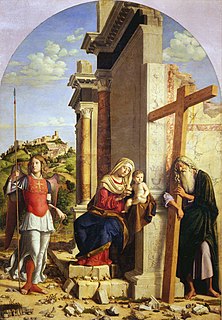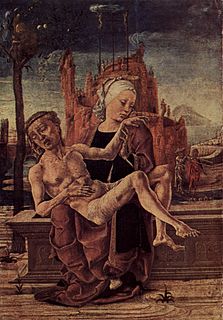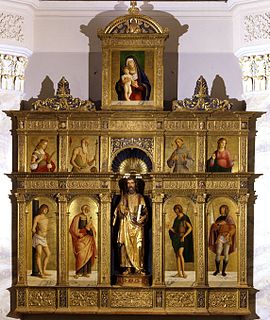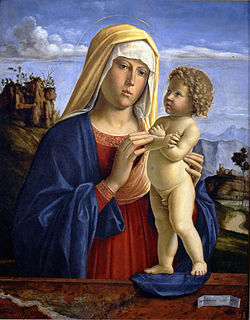
The Gallerie dell'Accademia is a museum gallery of pre-19th-century art in Venice, northern Italy. It is housed in the Scuola della Carità on the south bank of the Grand Canal, within the sestiere of Dorsoduro. It was originally the gallery of the Accademia di Belle Arti di Venezia, the art academy of Venice, from which it became independent in 1879, and for which the Ponte dell'Accademia and the Accademia boat landing station for the vaporetto water bus are named. The two institutions remained in the same building until 2004, when the art school moved to the Ospedale degli Incurabili.

Giovanni Battista Cima, also called Cima da Conegliano, was an Italian Renaissance painter, who mostly worked in Venice. He can be considered part of the Venetian school, though he was also influenced by Antonello da Messina, in the emphasis he gives to landscape backgrounds and the tranquil atmosphere of his works. Once formed his style did not change greatly. He mostly painted religious subjects, often on a small scale for homes rather than churches, but also a few, mostly small, mythological ones.

Marco Basaiti was a Renaissance painter who worked mainly in Venice and was a contemporary of Giovanni Bellini and Cima da Conegliano. He has been referred to by several names including Marco Baxaiti, Marcus Basitus, and Marcus Baxiti. There is little documentation on Marco Basaiti besides his painting signatures and a guild's ledger of 1530 ithat records him as a painter of figures.
Francesco Botticini was an Italian painter of the Early Renaissance. He was born in Florence, where he remained active until his death in 1498. Although there are only few documented works by Botticini, a considerable corpus has been confidently attributed to him on the basis of style including a number of altarpieces, dozens of small-scale religious panels and a few portraits.

The Musée Jacquemart-André is a private museum located at 158 Boulevard Haussmann in the 8th arrondissement of Paris. The museum was created from the private home of Édouard André (1833–1894) and Nélie Jacquemart (1841–1912) to display the art they collected during their lives.
The decade of the 1490s in art involved some significant events.

The Presentation of the Virgin Mary at the Temple is a painting by the Italian Renaissance master Cima da Conegliano, c. 1496–1497, in the Gemäldegalerie Alte Meister of Dresden, Germany, of the Presentation of Mary. The work presents the theme, apocryphal, but common in Christian art, of the presentation of the Virgin Mary in the Temple of Jerusalem, during her childhood.

The Musée des Beaux-Arts de Strasbourg is the old masters paintings collection of the city of Strasbourg, located in the Alsace region of France. The museum is housed in the first and second floors of the baroque Palais Rohan since 1898. The museum displays works by non-Upper Rhenish artists from between the 14th century and 1871 and by Upper Rhenish artist from between 1681 and 1871. The museum owned 1,934 works as of 31 December 2015, this number has substantially increased since. The old masters from the upper-Rhenish area until 1681 are exhibited in the neighboring Musée de l’Œuvre Notre-Dame.

The National Art Gallery of Bologna is a museum in Bologna, Italy. It is located in the former Saint Ignatius Jesuit novitiate of the city's University district, and inside the same building that houses the Academy of Fine Arts. The museum offers a wide collection of Emilian paintings from the 13th to the 18th century and other fundamental works by artists who were in some way related to the city.
Cesare da Conegliano was an Italian painter, known from a single work in Santi Apostoli, Venice.

The Madonna and Child with Saints Michael the Archangel and Andrea is a Cima da Conegliano painting oil on panel dating from c. 1496–1498, and preserved at the Galleria nazionale di Parma.

Pietà is a tempera on panel painting by Cosmè Tura, measuring 47.7 cm by 33.5 cm. It is now in the Museo Correr in Venice, to which it was left with the rest of the collection of Teodoro Correr on 1 January 1830. It was attributed to Luca d'Olanda until 1859, when Vincenzo Lazari recognised it as a work by Tura. By comparison with the same artist's Calliope and his Roverella Altarpiece, it has been dated to around 1460.

Olera Altarpiece is an oil on panel nine-panel altarpiece by Cima da Conegliano, created c. 1486–1488, housed in the parish church in Olera.

The Conegliano Altarpiece or Madonna and Child with Angels and Saints is an oil painting produced in 1492 by Cima da Conegliano as the high altarpiece for the Duomo di Conegliano in his birthplace.

Madonna and Child is an oil on panel painting by Cima da Conegliano, created c. 1504, that now hangs in the Uffizi in Florence. It has an early copy attributed to Antonio Maria da Carpi, now in the Musei civici di Padova.

Antonio Maria da Carpi was an Italian Renaissance painter.

Madonna of the Orange Tree is a 1496-1498 oil on panel painting by Cima da Conegliano. It was originally produced for the church of Santa Chiara in Murano, from which it was confiscated for the Gallerie dell'Accademia in Venice, where it now hangs.

Madonna and Child is an oil on panel painting by Cima da Conegliano, created in 1495, now in the Pinacoteca Nazionale di Bologna. A studio copy also survives in the Holburne Museum in Bath, Somerset, United Kingdom.

Madonna and Child with Saint Jerome and Saint John the Baptist is a 1492-1495 oil on panel painting by Cima da Conegliano, now in the National Gallery of Art (NGA) in Washington.

Madonna and Child is a 1504 oil on panel painting by Cima da Conegliano, now in a private collection. It was last sold at Christie's in London on 25 November 1966 as part of a sale of works from Sir Herbert Cook's collection and is therefore sometimes known as the Cook Madonna, not to be confused with another painting of that name by Crivelli now known to be the central panel of the Porto San Giorgio Altarpiece.

















